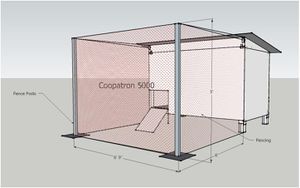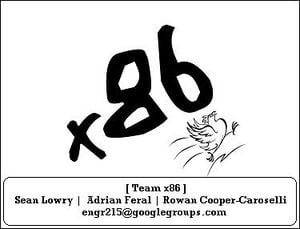
The Coopatron 5000 was designed in the Engineering 215 class instructed by Lonny Grafman within the Environmental Resources Engineering program at [Cal Poly Humboldt]. Our group is called Team x86. The context of our design project comes from the Waterpod Project, which is an attempt at sustainable water top living via the fusion of art and design. It is a collaborative effort to establish a communal living space that produces its own consumables. People from all over the world are working to get the barge ready for its maiden voyage in the summer of 2009. The barge will travel for six months, to six ports, in New York with the joint goals of supporting the life of its six human occupants and spreading awareness about sustainable living.
Objective[edit | edit source]
The coop is designed to supplement the dietary needs of the inhabitants while providing a comfortable shelter for the chickens living on Waterpod for the six month voyage.
Client Criteria[edit | edit source]
The Waterpod inhabitants made the following requests or the design:
- The coop needs to have eight to ten egg producing chickens for six months.
- The coop needs to be of a box frame design.
- The coop needs to provide opportunities for artistic collaboration.
- The coop waste products must be utilized for the composting toilette.
Project Requirements[edit | edit source]
| Criteria Weights | |
|---|---|
| Criteria | Average Weight |
| Cost | 10 |
| Ease of Assembly | 7.3 |
| Chicken Safety | 7 |
| Chicken Health | 7 |
| Ease of Transportation | 6.3 |
| Durability | 6.3 |
| Adaptability | 5 |
| Ease of Maintenance | 5 |
| User Safety | 3.6 |
Overview[edit | edit source]
The basic criteria that team x86 determined for the design of the project was extracted from the best aspects of our alternative designs (Figure 1) and extensive research. Each Criteria is explained in detail below.
Cost[edit | edit source]
The maximum allowed budget for each design is $225. The least costly design is favorable due to this restriction.
Ease of Assembly[edit | edit source]
Two adults must be able to assemble the coop in one day given our instructions and adequate tools.
Chicken Safety[edit | edit source]
The Coop must prevent the Chickens from sustaining any injury.
Chicken Health[edit | edit source]
The coop must shelter the chickens from the elements, keep them warm and cool enough, and give them non drafty air flow. They also need soft and absorbent bedding to nest in. Their dietary needs must also be addressed by the design.
Ease of Transportation[edit | edit source]
Because the project must be shipped long distance in limited space it needs to be collapsible so it can fit in a small area.
Durability[edit | edit source]
The coop needs to last at least six months - although longer the better.
Adaptability[edit | edit source]
The coop needs to be an artistic workspace as well as a house for chickens. The more opportunities for artistic collaboration there are the better.
Ease of Maintenance[edit | edit source]
The coop should be as easy to clean and maintain as possible, the maintenance of the coop should take around two and a half hours per week.
User Safety[edit | edit source]
The coop must be free of any hazards to the user; it should present no risk of serious injury and as minimal risk of minor injury as possible.
Project Design[edit | edit source]
Specifications[edit | edit source]
The Coopatron 5000 utilized mostly recycled building materials (Figure 2a). The frame consists of 2x4's while the panels are made of plywood (Figures 2b-2C). The design needs to have proper ventilation panels that keep the chickens from asphyxiating as a result of their waste products. A ten gallon trash can contains feed and is located separately from the chicken coop, and standard chicken water dispenser is located on the floor of the coop. The bedding material is designed to be recycled as a bulking agent for the composting toilette. The coop will also be used as a canvas for any artistic additions the occupants of the barge wish to include. The design should be easily adapted as a canvas for paints or other artistic additions because of the large flat panels. The access panels should serve for easy cleaning and egg collection while there will be nothing in the design of the Coopatron 5000 that presents a hazard to the person maintaining it.
-
Figure 2a: Recycled Building Materials
-
Figure 2b: Assembling The Structure
-
Figure 2c: Frame Assembly
Finished Design[edit | edit source]
The final chicken coop solution is coined the Coopatron 5000 (Figure 3a). The design integrates research from the literature review and designs from each of alternative solutions. The coop has the capacity to house ten chickens comfortably(Figure 3b). The dimensions are roughly 7' x 4' x 5' and instills the proper ventilation and easy maintenance access (Figure 3c-3d).
-
Figure 3a: The Coopatron 5000
-
Figure 3b: CAD Image of Coop Components
-
Figure 3c: Access Doors
-
Figure 3d: Ventilation
Costs[edit | edit source]
The Coopatron 5000 was fairly inexpensive (Seen in graph below) as it was built mostly from recycled building materials. Although, if materials were bought at the market price the cost may exceed the Estimated $270.
| Materials and Costs | |||
|---|---|---|---|
| Item | Quantity | Team x86 Cost ($) | Market Cost ($) |
| 4'x8' - 3/8" Plywood | 1 | Free | 12.99 |
| 4'x8' - 1/8" Plywood | 6 | Free | 119.94 |
| 2"x4"x8" Pine | 10 | Free | 19.90 |
| 1/2" Metal Tubing (15ft.) | 1 | Free | 15.00 |
| Large Hinges | 2 | 4.00 | 4.00 |
| Small Hinges | 6 | Free | 6.50 |
| Screws - Structure 4" 1lb | 1 | 4.00 | 4.00 |
| Latches | 3 | 9.00 | 9.00 |
| Handles | 4 | Free | 4.00 |
| Screws - Mounting 1.5" 1lb | 1 | 7.00 | 7.00 |
| Paint 1gal. | 1 | Free | 20.00 |
| Plastic Sheeting | 1 | Free | 10.00 |
| Plastic Gutter Shielding | 1 | Free | 3.00 |
| Construction Fencing | 1 | Free | 15.00 |
| Feed Holder | 1 | Free | 10.00 |
| Water Holder | 1 | Free | 10.00 |
| Total Cost | 24.00 | $270.33 | |
Maintenance[edit | edit source]
The maintenance of the Coopatron 5000 was estimated to be two hours and twenty one minutes a week, as seen in the graph below. A template of the weekly routines were outlined in a maintenance chart found here, which may be downloaded and applied as a basic template for numerous chicken coops.
| Average Weekly Maintenance | ||
|---|---|---|
| Task | Estimated Time (Minutes) | Frequency |
| Egg Collection | 3 | Daily |
| Feeding | 3 | Daily |
| Watering | 3 | Daily |
| Check Coop Environment | 3 | Daily |
| Observe Chicken Health | 5 | Biweekly |
| Change Bedding | 15 | Weekly |
| Check For Structural Degradation | 5 | Weekly |
| Cleaning | 15 | Bimonthly |
| Total Weekly Time: 2 Hours 21 Minutes | ||
Information and Contact Details[edit | edit source]

Links[edit | edit source]
The Waterpod Project - http://www.thewaterpod.org/
Engineering 215: Introduction to Design - https://www.appropedia.org/Category:Engr205_Introduction_to_Design
Lonny Grafman - https://www.appropedia.org/User:Lonny
Environmental Resources Engineering Department - http://web.archive.org/web/20090606001446/http://www.humboldt.edu:80/~ere_dept/
Cal Poly Humboldt - http://www.humboldt.edu/






